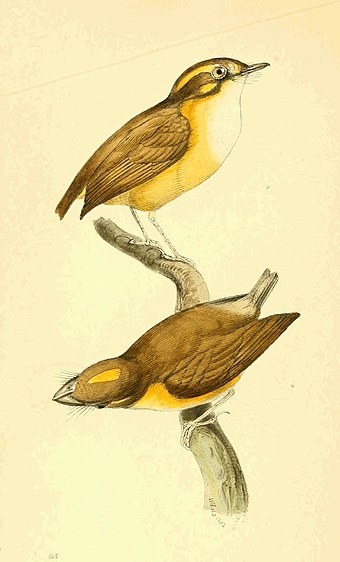Zoological Illustrations/VolII-Pl115

PLATYRHYNCHUS cancromus. fem.
Short-tailed Flatbill.
Generic Character.
- Platyrhinchos, Temminck. Sw. Zool. Ill. (div. I.) Vol. i. pl. 13.
- Rostrum tenue, breve, valdè depressum, frontis latitudinem superans, mandibulæ superioris abruptè aduncæ, et ad apicem emarginatæ, marginibus dilatatis, et inferioris margines superplicantibus. Nares medii, basi membranâ pennis minutis instructâ obtectâ, aperturâ parvâ, rotundâ, terminali, tantùm non nudâ. Rictus ampli, ad mandibulæ superioris basin vibrissis rigidis armati. Pedes sedentes, graciles, digitis lateralibus imparibus, digito exteriore ad medii digiti articulum primum annexo, halluce valido.
- Bill thin, short, very much depressed, broader than the front of the head; the upper mandible abruptly hooked and notched at the tip; the margins dilated, and folding over those of the under mandible; nostrils central, the base covered with a membrane having minute feathers, the aperture small, round, terminal, and nearly naked; mouth large, armed above with stiff bristles; feet sitting, slender; lateral toes unequal, exterior united to the middle as far as the first joint; hinder claw strongest.
Specific Character.
- P. (fem.) suprà olivaceo-fuscus, infrâ pallidè fulvus; jugulo albo; genis pennisque spuriis nigris; strigâ ante et pone oculum, maculoque auriculari albentibus.
- (Female) above olive-brown; beneath pale fulvous; throat white; ears and spurious quills black; stripe before and behind the eye, and spot on the ears whitish.
- Platyrhinchos cancromus. (male?) Temminck and Laugier. Pl. Col. Pl. 12. f. 2.
The remarkable breadth of the bill, and the extreme shortness of the tail, in this bird, render it a very singular little creature. Though a native of Brazil, I never met with it during my travels in that country; and the only specimen I have yet seen belongs to Mr. Leadbeater. The figure of P. cancromus of Professor Temminck, differing only from this bird in having a yellow crest, leads me to believe they are sexes of the same species; this being the female bird. The tail in the male appears to be somewhat longer, but this may be an error of delineation, and the description has not yet been published.
The figure is of the natural size, and below is an outline of the bill and nostrils; these latter are depressed, and the base covered with thickset feathers; the aperture is naked, round, and piercing the membrane in a lateral direction, midway between the ridge and margin of the bill, and at the end of the nasal membrane. The plumage above fulvous brown: darker, and tinged with reddish on the margin of the quills and tips of the wing covers: spurious quills and stripe beneath the eyes black: the upper part of the ears are also black, the lower half whitish yellow; chin and throat whitish; breast and body beneath pale fulvous brown; tail remarkably short, and not projecting beyond the wings; upper mandible black, lower white.
Since the publication of the remarks on this genus at Plate 14, a further consideration of the subject induces me to adopt the opinion of Professor Temminck, in placing the Todus Platyrhynchos, Gm., and its allies, under a distinct genus; or, in other words, of detaching from this group the second division annexed to my former definition of this genus. Still, however, the close affinities I have there pointed out, render the generic situation of several of these birds very doubtful; because the transition from one to the other is so gradual that even the most accurate set of generic characters, founded on the bill, will not clearly define the limits between the genera Platyrhynchus and Muscipeta. Their anatomy might do so, but on this subject we are quite ignorant.
I can gather nothing from the characters which Dr. Horsfield has given in the Linnæan Transactions of his new genus Eurylaimos; which does not perfectly agree with those of Platyrhynchus. It appears to have precisely the same formation of bill, nostrils, legs, &c. as P. cancromus, but in a higher state of development; thus strengthening the opinion I have above expressed.
